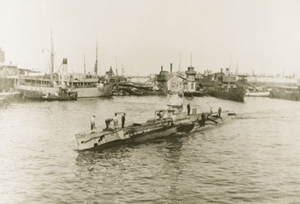HMS E9
|
|
|
|---|---|
 The British submarine HMS E19 , a sister boat of HMS E9 , in the port of Reval |
|
| Construction data | |
| Ship type | Submarine |
| Ship class | E class |
| Construction designation: | |
| Builder: |
Vickers Ltd. in Barrow-in-Furness construction no .: 4 ?? |
| Keel laying : | June 1, 1912 |
| Launch : | October 29, 1913 |
| Completion: | June 16, 1914 |
| Building-costs: | £ 105,700 |
| Technical specifications | |
| Displacement : | 662 ts standard 807 ts submerged |
| Length: | 55.6 m |
| Width: | 6.86 m |
| Draft : | 3.81 m |
| Drive : | 2 × diesel engines with 1600 HP 2 × electric motors 840 HP 2 propellers |
| Fuel supply: | 40 t |
| Speed : | 15.25 kn surfaced 9.75 kn submerged |
| Range : | 3,200 nm surfaced at 10 kn 95 nm submerged at 3 kn |
| maximum diving depth: | 200 ft (approx. 60 m) |
| Crew : | 30 men |
| Armament: | 5 × 18 inch (457 mm) torpedo tubes 5 reserve torpedoes 1 × QF 12 pounder 18 cwt naval gun |
HMS E9 was an E-class submarine of the British Royal Navy that was in service in both the North Sea and the Baltic Sea during World War I.
The E9 belonged to a slightly improved subgroup of 46 boats comprising the E-class submarines, which at the beginning of the First World War represented the most powerful and newest medium-sized submarine in the Royal Navy.
The boat was put into service under Lt. Cdr. Max Horton assigned to the 8th submarine flotilla based in Harwich and used for patrol trips in the North Sea.
Operations in the First World War
North Sea
With the start of the fighting at sea, the boat carried out patrols within the German Bight to clear up the German outpost forces. During the first sea battle near Heligoland on August 28, 1914, E9 was part of the first attack strip, consisting of the two sister boats HMS E4 and HMS E5 , which was supposed to intercept the expected German armed forces. The submarines only played a very subordinate role during this action.
The boat then resumed patrol activities and was able to sink the older small cruiser SMS Hela with a torpedo on September 13, 1914, about six nautical miles southwest of Heligoland . E9 was then chased by German units all day, but escaped to Harwich . When entering the port, Horton established the tradition of British submarines to set the Jolly Roger pirate flag after a successful sinking . Three weeks later, on October 6, 1914, Horton had another success against a German warship: at around 1 a.m. he sank the torpedo boat S 116, which belonged to the 7th torpedo boat semi-flotilla led by Georg Thiele and was sailing in front of the Borkum outpost . Max Horton received the Distinguished Service Order in December 1914 for the sinking of the two ships .
Baltic Sea
In mid-October 1914, HMS E9 was supposed to move together with the sister boat HMS E11 through the Öresund to the Baltic Sea to support the Russian Baltic fleet there and to combat German merchant shipping to the Scandinavian countries. After being sighted by a German seaplane, HMS E11 broke off its breakthrough through the Öresund and returned to its home base, while on October 18, 1914, HMS E9 succeeded in forcing the strait and the boat called at the assigned base in Libau . Subsequently, with the aim of sinking German warships, Horton undertook extensive voyages in the central and western Baltic Sea. Among other things, he penetrated the Bay of Kiel and permanently worried the Imperial Navy with his actions. During the winter the boat was forced to be inactive due to the icing of the Russian ports.
In 1915, Horton resumed patrol activities with his boat, and he was able to achieve further great success. On May 11, 1915, he was shot off Polangen with two torpedoes against the large cruiser SMS Roon , which the cruiser was able to avoid. On June 5, HMS E9 was able to seriously damage the torpedo boat S 148 during the coal takeover off the west coast of Gotland and sink the coal steamer Dora Hugo Stinnes . On July 2, 1915, in front of Rixhöft , Horton was able to severely damage the large cruiser SMS Prinz Adalbert with a torpedo in support of the mine cruiser SMS Albatross (see: Gotland Raid ), which was in combat with the Russian armed forces . In August of that year, five German merchant ships were sunk to bring merchandise from Sweden to the blocked German Reich.
Horten left the boat in January 1916 and put the new submarine HMS J6 into service in the UK while Lt. Cdr. Hubert Vaughan-Jones became the new commander of E9 .
After the organization of a convoy system for the German merchant ships from 1916, the successes declined noticeably. The boat was in use, interrupted by the seasonal icing of the Baltic Sea, until it scuttled due to the German intervention in Finland until April 1918. On April 8, 1918, when Helsingfors was occupied, HMS E9 was self- sunk 1.5 nm south of the Harmaja lighthouse with three sister ships , so as not to let it fall into German hands. The wreck was lifted by a Finnish salvage company in August 1953 and then scrapped.
Web links
- Successes against merchant ships in October 1915
- Finnish side to E9
- about Max Horton
- Side to the boat
Footnotes
- ↑ S-116 (+1 914) In: wrecksite.eu , accessed on May 27, 2019